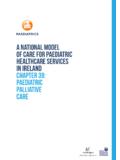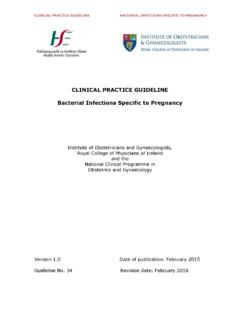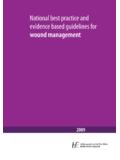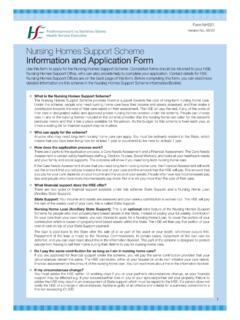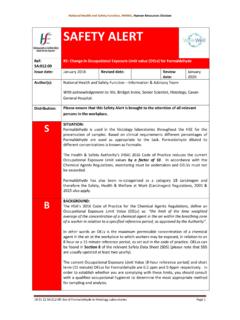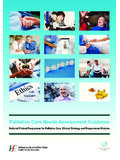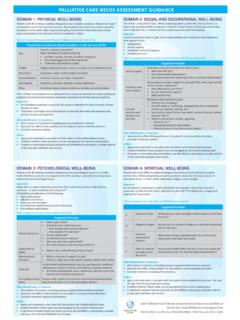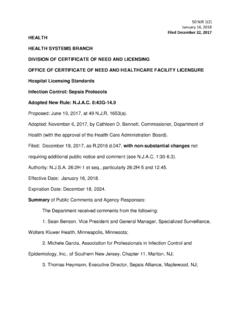Transcription of Sepsis Management - Ireland's Health Services
1 Sepsis Management National Clinical Guideline No. 6 November 2014 National Clinical Guideline No. 6 ISSN 2009-6259 Published November 2014 DisclaimerThe Guideline Development Group s expectation is that healthcare staff will use clinical judgement, medical, nursing and midwifery knowledge in applying the general principles and recommendations contained in this document. Recommendations may not be appropriate in all circumstances and the decision to adopt specific recommendations should be made by the practitioner taking into account the individual circumstances presented by each patient/resident and available resources. The National Clinical Guideline recommendations do not replace or remove clinical judgement or the professional care and duty necessary for each specific patient case.
2 Therapeutic options should be discussed with a clinical microbiologist or infectious disease physician on a case-by-case basis as this National Clinical Guideline The aim of the National Clinical Guideline is to facilitate the early recognition and appropriate treatment of Sepsis in Ireland in order to maximise survival opportunity and minimise the burden of chronic sequelae. The summary document of the National Clinical Guideline is available at: are presented with practical guidance. The recommendations are linked to the best available evidence and/or expert opinion using the grades for recommendations. The National Clinical Guideline recommendations have been cross-referenced where relevant with other National Clinical Guidelines. National Clinical Effectiveness Committee (NCEC)The National Clinical Effectiveness Committee (NCEC) is a Ministerial committee established as part of the Patient Safety First Initiative.
3 The NCEC role is to prioritise and quality assure National Clinical Guidelines and National Clinical Audit so as to recommend them to the Minister for Health to become part of a suite of National Clinical Guidelines and National Clinical Audit. National Clinical Guidelines which have been quality assured and recommended by NCEC for implementation provide robust evidence-based approaches to underpin or define models of care as appropriate. They provide guidance and standards for improving the quality, safety and cost-effectiveness of healthcare in Ireland. The implementation of clinical guidelines can improve Health outcomes, reduce variation in practice and improve the quality of clinical Terms of Reference- Apply criteria for the prioritisation of clinical guidelines and audit for the Irish Health system - Apply criteria for quality assurance of clinical guidelines and audit for the Irish Health system - Disseminate a template on how a clinical guideline and audit should be structured, how audit will be linked to the clinical guideline and how and with what methodology it should be pursued - Recommend clinical guidelines and national audit, which have been quality assured against these criteria.
4 For Ministerial endorsement within the Irish Health system - Facilitate with other agencies the dissemination of endorsed clinical guidelines and audit outcomes to front-line staff and to the public in an appropriate format - Report periodically on the implementation of endorsed clinical guidelines. In response to the HIQA Patient Safety Investigation Report into Services at University Hospital Galway (2013), the NCEC was requested by the Minister for Health to commission and quality assure a number of National Clinical Guidelines. The National Clinical Guideline for Sepsis Management is one of these guidelines. The National Clinical Guideline Sepsis Management has been quality assured by NCEC and endorsed by the Minister for Health for implementation in the Irish healthcare on the NCEC and endorsed National Clinical Guidelines is available at this National Clinical Guideline Sepsis is common and is a time-dependent medical emergency.
5 It can affect a person of any age, from any social background and can strike irrespective of underlying good Health or concurrent medical conditions. International Sepsis campaigns that have introduced and promoted an approach to Sepsis care based on early recognition of Sepsis with resuscitation and timely referral to critical care have reported reductions in mortality from severe Sepsis /septic shock in the order of 20-30%.This National Clinical Guideline is intended to be relevant to all healthcare staff involved in the care of patients who have Sepsis . The Guideline Development Group consisted of a subgroup of the National Sepsis Steering Committee with expertise in guideline and early warning score implementation, Sepsis Management and emergency care.
6 The Guideline Development Group has provided a number of recommendations to assist healthcare staff in the identification and Management of patients with Sepsis . A summary version of the National Clinical Guideline outlining the key recommendations, is available at: recommendations align with the aims of the national Sepsis work stream. Key recommendations are linked with other recommendations, practical guidance, roles, responsibilities and processes. The recommendations are linked to the best available evidence and/or expert opinion using the GRADE system for grading recommendations. This guideline is available to all clinicians in the Republic of Ireland involved in the diagnosis and Management of patients with wish to acknowledge all the members of the National Sepsis Steering Committee and the Guideline Development Group members (Appendix 1) who gave freely of their time and expertise.
7 A special word of thanks to the external expert, Prof. Kevin Rooney, National Clinical Lead on Sepsis , Healthcare Improvement Scotland and Professor of Care Improvement, University of the West of Scotland and the validators Dr. John Bates from the Joint Faculty of Intensive Care Medicine in Ireland and Dr. Christian Subbe, Consultant in Acute, Respiratory and Critical Care Medicine and Senior Clinical Lecturer at the School of Medical Sciences, Bangor University, UK. Many thanks go to Ms. Clodagh Murray, Library Assistant, HSE South East Library Service, University Hospital Waterford for prompt research support and also to Ms. Grainne Cosgrove, Health Information Unit, Department of Health for providing extensive support regarding HIPE data analysis.
8 We also wish to acknowledge the contribution of the National Cancer Control programme (NCCP) in support of this guideline. Dr. Fidelma Fitzpatrick, Chair, National Sepsis Steering Committee, November 2014Dr. Vida Hamilton, National Sepsis Lead, Chair, Guideline Development Group November 2014 Table of ContentsSection 1: Sepsis impact 9 Definitions 9 Clinical impact of Sepsis 10 The burden of Sepsis in Ireland 12 Adapting the surviving Sepsis campaign guidelines 15 Pathway of care for Sepsis 15 Diagnostic criteria for Sepsis 17 Detection and recognition 19 Communication ISBAR communication tool 22 Resuscitation and referral 22 Source control 23 Section 2: National Clinical Guideline recommendations 25 National recommendations 25 Screening, Sepsis 6, 3 hour and 6 hour bundles 26 Initial resuscitation and infection issues 35 Other national recommendations 39 Haemodynamic support and adjunctive therapy 39 Other supportive therapy of severe Sepsis 42 Special considerations in paediatrics 47 Section 3.
9 National Clinical Guideline processes 56 Aim and scope of the National Clinical Guideline 56 Methodology 56 Preparation module 56 Adaptation process 57 Financial impact of Sepsis 59 External review 59 Procedure for update of this guideline 59 Implementation of this guideline 60 Emergency department/Acute Medical Assessment Units (AMAUs) 60 Education program 60 Process of implementation 60 Audit criteria 62 Measuring Improvements in hospitals 63 Measuring Improvements in Ireland 63 Measurement plan 63 Balancing measures 64 Appendices:Appendix 1:National Sepsis steering committee 65 Appendix 2: The National Early Warning score card 69 Appendix 3:ISBAR communication tool patient deterioration 70 Appendix 4:Adult in-patient Sepsis screening form (sample) 71 Appendix 5: Emergency department Sepsis pathway (sample) 72 Appendix 6: Start Smart, Then Focus antibiotic care bundle 75 Appendix 7: SIRS criteria 76 Appendix 8: Sample fluid resuscitation algorithm for adults with Sepsis 78 Appendix 9: IMEWS chart (sample) 79 Appendix 10: Guideline internet databases searched 82 Appendix 11: SCC Agree II reviewers comments 83 Appendix 12: Sample driver diagram for improving care of patients with Sepsis in the emergency department 86 Appendix 13: Summary of ADAPTE process 87 Appendix 14: Budget impact analysis 88 Appendix 15: HIPE codes used for Sepsis case analysis 107 Appendix 16.
10 Glossary of terms 109 References 110 List of tablesTable 1 Prevalence of sources of Sepsis 10 Table 2 Hospital Inpatient Enquiry: Proportion of deaths with a diagnosis of Sepsis or infections, 2013 13 Table 3 Hospital Inpatient Enquiry: Inpatients with a diagnosis of Sepsis or infections, 2011 - 2013 13 Table 4 Infection, documented or suspected, and some of the following: 17 Table 5 Risk Factors for the development of Sepsis in pregnancy 20 Table 6 Sources of maternal infection in severe Sepsis 20 Table 7 Organisms isolated in severe maternal Sepsis 20 Table 8 Modified SIRS criteria for maternity patients 21 Table 9 GRADE evidence quality classification 25 Table 10 Summary of national recommendations 26 Table 11 Lactate levels and associations with percentage mortality 28 Table 12 Balancing measures for monitoring implementation of Sepsis 6 64 List of FiguresFigure 1 Summary of diagnosis of Sepsis 18 Figure 2 Summary of pathway of care for patients presenting with Sepsis 18 Figure 3 Care pathway for the deteriorated critically ill pregnant woman 21 Figure 4 ISBAR communication tool 22 Figure 5
